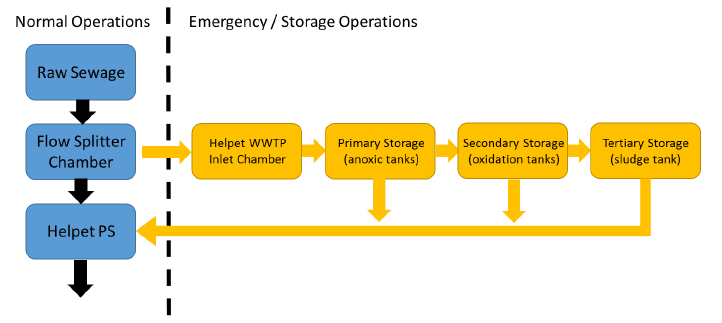<<
5-Waters-Volume-3-Wastewater
12 Rolleston Wastewater Scheme
12.1 Scheme Summary
Estimated Population Served
| 21,875
|
Scheme Coverage (1 Jan 2021)
| Full Charges | 6,338
|
| Half Charges | 1,120
|
>1 Charges
| 80
|
System Components
| Piped (m)
| 260,410
|
| Manholes (No.) | 2,364
|
| Pump Stations (No.) | 13
|
| Treatment | N/A (to Pines WWTP) |
| Disposal | N/A (to Pines WWTP) |
| History | Original scheme installation date | 1996
|
Value ($)
| Replacement Cost | $88,879,203
|
| Depreciated Replacement Cost | $79,467,080
|
| Financial | Operator cost (scheduled and reactive maintenance) per connection
| $45.54/connection
|
Demand
(1 Jan - 31 Dec 2020)
| Annually (m3) | 1,513,542
|
| Average daily (m3) | 4,135
|
| Peak daily (m3) | 6,764
|
| Minimum daily (m3) | -
|
| Infiltration | Yes
|
| Sustainability | Ultimate discharge point | To Pines WWTP |
12.2 Key Issues
The following key issues are associated with the Rolleston Wastewater Scheme. A list of district wide issues are located in 5Waters Activity Management Plan: Volume 1.
Table
12‑1 Rolleston Scheme Issues
| Meeting growth requirements | Complete capital upgrade program to meet growth demand. |
12.3 Overview & History
For Rolleston, the community was initially developed with onsite treatment and disposal of wastewater via septic tanks. Developers identified the potential for the growth in the town with availability of land for subdivision and proximity to major service routes to Christchurch, and to the west coast.
The town's original wastewater treatment plant (WWTP), known as the Rolleston (Helpet) WWTP was built by private developers (Helpet Investments Ltd) and commissioned in 1996, with a design population capacity of 4,400 population equivalents - the forecasted town population at that time. Testing of Helpet WWTP revealed the disposal area had a reduced capacity due to soil types and the treatment plant could only manage 3900 population equivalents, utilising grass cut and carry.
Following approval in 2003 to further expand the town to 14,000 population equivalents, additional wastewater treatment and disposal capacity was required. Resource consents for a new WWTP within the Selwyn Plantation (hence the name of 'Pines' I WWTP), some 5 km from the town were granted in December 2003. The plant was constructed in 2006 and commissioned in 2007 to provide an additional capacity of 6,000 population equivalents.
All Rolleston wastewater is now treated and disposed of at the Pines Treatment Plant, see Section 5.0 for more details about the treatment plant.
The Helpet WWTP has now been decommissioned from service and being upgraded to provide flow buffer storage. The Helpet pump station was diverted in early 2015 to the west of the site to connect to the new Selwyn Road pump station. A contamination report was commissioned for the site and confirm that the site was appropriate for development.
The IZone industrial park is connected to the Rolleston wastewater network, with the largest customer being Westland Dairy. Ongoing expansion of Westland Dairy and the IZone development will utilise spare capacity in the wastewater network.


Figure
12‑2 Scheme Schematics x2

Figure
12‑3 Rolleston Master Plan

Figure
12‑4 Pump Station Failure Map
12.4 System Capacity
In recent years there has been rapid residential growth in the Rolleston and West Melton communities. This has placed a strain on the existing wastewater collection system. Therefore, with the implementation of the ESSS, the wastewater system has been expanded in stages to meet the increasing flows. A wastewater masterplan has been established to structure the expansion of scheme to meet the timing of new development. The capacity of existing catchment pump stations, while not yet reached, will need to be monitored and upgraded as pump renewals are considered. Figure 12‑5 below shows the predicted population growth for Rolleston.

Figure
12‑5 Projected PE Growth - Rolleston & West Melton

Figure
12‑6 Wet Weather Flow Capacity Map
12.5 Resource Consents
Rolleston township is part of the ESSS scheme. Therefore, all wastewater is pumped to the Pines Treatment Plant. The resource consents required for this treatment plant are in the ESSS section of this plan. Consents for the old treatment plant are still active, however the majority of this site is no longer operational. The consents for the Helpet plant are shown below in Table 12‑2.
Table
12‑2 Resource Consents
CRC950311.1
| To discharge contaminants (including odours and aerosols) into the air from spray and trickle irrigation of treated domestic sewage effluent onto 13.8 hectares of land, from the storage of sewage screens and sludge from an extended aeration sewage treatment plant located between Springston Rolleston and Lincoln Rolleston Roads, at or about map reference M36:614-337. | BTWN Springston-Rolleston & Springston-Lincoln Roads, ROLLESTON | 12-Dec-00 | 31-Mar-30 | N/A
|
CRC950310.2
| To discharge contaminants to land | BTWN Springston-Rolleston & Springston-Lincoln Roads, ROLLESTON | 17-Mar-05 | 31-Mar-30 | 110 |
12.6 Scheme Assets
A summary of the assets within this scheme is outlined in this section.
12.6.1 Reticulation Overview
A summary of material and diameter for pipes is shown in Figure 12‑7 and Figure 12‑8.
Figure
12‑7 Pipe Material - Rolleston
Figure
12‑8 Pipe Diameter – Rolleston
12.6.2 Treatment and Disposal
Further reference to the treatment and disposal of Rolleston wastewater is described in Section 5.0.
12.6.3 Design
The wastewater collection system has been designed in accordance with the appropriate New Zealand engineering design guidelines at the time of construction and in accordance with the Selwyn District Council Engineering Design Standards. Specific designs for portions of the scheme outside of these standards have been considered where detailed engineering designs have been provided.
12.6.4 Pump Stations
There are a total of seven pump stations with the details outlined in Table 12‑3 below.
Pump stations where the standby / assist pump is predicted to start have been highlighted in
yellow and
red for those that experience a peak wet weather response.
Yellow Pumps are can convey the peak flow without backing up the system
Red Pumps are unable to convey the peak flow causing the system to back up
Table
12‑3 Pump Station Overview
| Rolleston (S) Boulez Mews PS | 1800Ø | 2 | Flygt 3068 170 HT216 | 2.5 | 3.0 | 0.1 | 0.3 | 0.3 |
| Rolleston (S) George Holmes Dr PS | 3050Ø | 2 | Flygt 3202 180 MT431 | 70 | 64 | 8.4 | 8.9 | 8.9 |
| Rolleston (S) Goldrush Ln PS | 1800Ø | 2 | Flygt 3085 183 HT481 | 20 | 17 | 0.6 | 1.6 | 1.6 |
| Rolleston (S) Goulds Rd PS | 2400Ø | 2 | Flygt 3127 180 HT481 | 15 | 18 | 4.1 | 13.6 | 13.6 |
| Rolleston (S) Helpet PS | 3000 x 2500 | 2 | Flygt 3202 180 HT450 | 110-140 | 105-135 | 18.1 | 51.1 | 50.8 |
| Rolleston (S) Marlowe Pl PS | 1800Ø | 2 | Flygt 3085 183 MT461 | 8 | 8.4 | 0.2 | 0.5 | 0.5 |
| Rolleston (S) Runners Rd PS | 2600Ø | 2 | Flygt 3102 181 MT461 | 16
| 17 | 1.0 | 2.0 | 2.0 |
Table
12‑4 Pump Station Storage Time Analysis
| Rolleston (S) Boulez Mews PS | Subdivision | 47.9 | 50.7 | 551108 |
| Rolleston (S) George Holmes Dr PS | Service industrial area - has capacity to service Izone industrial area | 6.9 | 8.1 | 551007 |
| Rolleston (S) Goldrush Ln PS | Lift station to reticulation flowing to Helpet | NA | NA | NA |
| Rolleston (S) Goulds Rd PS | Lift station to reticulation flowing to Helpet | 4.5 | 6.8 | 550248 |
| Rolleston (S) Helpet PS | Lift sewage up to new gravity line to Selwyn Road Pump station | 12.3 | 15.1 | 550166 |
| Rolleston (S) Marlowe Pl PS | Subdivision | 27.3 | 30.0 | 551137 |
| Rolleston (S) Runners Rd PS | Services the Department of Corrections and CYFS | 73.5 | 74.7 | 542308 |
12.6.5
Helpet Emergency Storage
Since the completion of the upgrade to the Pines WWTP in 2012, the Helpet WWTP is now no longer in service as a treatment facility. The existing site was repurposed as an emergency wastewater storage facility. Figure 12‑9 shows the path of the wastewater within the facility.

Figure
12‑9 Flow Diagram showing path of the wastewater
Under normal operation, wastewater from the upstream catchment enter the site via the flow splitter chamber. Flow is then diverted into the Helpet Pump Station (PS) wet well through a DN375 pipe. The wastewater is then pumped to the Farrington gravity trunk main. Under normal operations, the storage facilities will not be used.
In the event the pumps are unable to match the incoming flow or a mechanical/electrical failure of the Helpet pump station occurs, the water level will rise in the wet well and the flow splitter chamber. If the level rises high enough, it will begin to spill over a fixed weir to the Helpet inlet chamber / pump station and then to the primary storage tanks (previously operating as anoxic tanks under their previous WWTP function).
The tanks will fill sequentially. As each tank reaches its top water level, a steel box weir will convey flows to begin to fill the next tank. Sequential filling minimises the effort required to wash down the tanks after an event. Once the primary tanks are full, flows are then conveyed via a terminal weir to the secondary storage tanks (previously operating as Oxidation tanks under their previous WWTP function). The final chamber within the storage system is the tertiary chamber (previously operating as the sludge storage tank under their previous WWTP function).
A separate circuit of DN150 pipes returns flow back to the pump station. “WaStop" sock type check valves in the return circuit ensure the tanks cannot fill via these pipes. Table 12‑5 shows the volume and spill level (slightly below the top water level) of each of the tanks.
Table
12‑5 Summary of the volume and assumed safe top weir level of the storage facilities
| Old Inlet PS | 11.2 | 45.67 |
| Tank 1 | 63.5 | 45.63 |
| Tank 2 | 61.9 | 45.62 |
| Tank 3 | 60.2 | 45.58 |
| Tank 4 | 58.56 | 45.55 |
| Ditch 1 (Sth) | 218.9 | 45.51 |
| Ditch 2 (Sth) | 209.2 | 45.48 |
| Sludge tank | 17.8 | 45.45 |
12.6.6 Rising Mains
Table 12‑6 Rising Main Overview
| Rolleston (S) Boulez Mews PS | Rolleston | 94 | 0.2 | 0.1 | 0.5 | 0.0 | 0.5 | 110 | No data
|
Rolleston (S) George Holmes Dr PS
| Rolleston | 2,501 | 158.1 | 8.4 | 5.2 | 0.0 | 5.2 | 315 | No data |
| Rolleston (S) Goldrush Ln PS | Rolleston | 23 | 0.2 | 0.6 | 0.1 | 0.0 | 0.1 | 20 | No data |
| Rolleston (S) Goulds Rd PS | Rolleston | 524 | 8.3 | 4.1
| 0.6 | 0.0 | 0.6 | 105 | No data |
| Rolleston (S) Helpet PS | Rolleston | 942 | 27.6 | 18.1 | 0.2 | 1.1 | 1.3 | 295 | 95 – 180** |
| Rolleston (S) Marlowe Pl PS | Rolleston | 160 | 1.4 | 0.2 | 2.1 | 0.0 | 2.1 | 30 | No data |
| Rolleston (S) Runners Rd PS | Rolleston | 475 | 7.9 | 1.0 | 2.3 | 0.0 | 2.3 | 40 | No data |
12.7 Operational Management
The wastewater schemes are operated and maintained under the maintenance contract as follows:
- Contract 1241: Water Services Contract. Contract is with SICON who undertakes investigations, conditions inspections, proactive and reactive maintenance and minor asset renewals.
Wastewater sampling is completed under an agreement with Food and Health Ltd as required.
12.8 Photos of Main Assets

Photo 1 Helpet Pump Station
| 
Photo 2 - Burnham School Road Pump Station
|
12.9 Risk Assessment
A risk assessment has been undertaken for the Rolleston scheme. The key output from the risk assessment is the identification of any extreme and high risks which need to be mitigated. In order to mitigate these risks they have been included and budgeted for in the projects within this LTP. Table 12‑7 details the risk priority rating, Table 12‑8 outlines the risks and the list of key projects is found in Table 12‑13.
Table
12‑7 Risk Priority Rating
| > 50 | Extreme | Awareness of the event to be reported to Council. Urgent action to eliminate / mitigate / manage the risk. Document risk and action in the AMP. |
| 35-50 | Very High | Risk to be eliminated / mitigated / managed through normal business planning processes with responsibility assigned. |
| 14-35 | High | Manage risk using routine procedures. |
| 3.5-14 | Moderate | Monitor the risk. |
| < 3.5 | Low | Awareness of the event to be reported to Council. Immediate action required to eliminate / mitigate / manage the risk. Document risk and action in the AMP. |
Table
12‑8 Risks - Rolleston
| Increased loading from development overloads pump station | Upgrade pumps (one) in Goulds Road | 2014 | 45 | 45 | 20 |
The list of district wide risks can be found in 5Waters Activity Management Plan: Volume 1.
12.10 Asset Valuation Details
The total replacement value of assets within the Rolleston Scheme is $88,879,203 as detailed in Table 12‑9 below.
Table
12‑9 Replacement Value, Rolleston
Plant and Equipment
| $2,456,113
|
Wastewater Reticulation
| Chamber | $320,073
|
| Lateral | $25,300,018
|
| Manhole | $13,453,794
|
| Pipe | $47,193,096
|
| Valve | $153,843
|
12.11 Renewals
The renewal profile has been taken from the 2019 5 Waters Valuation. A graph showing the renewals for this scheme are shown by Figure 12‑10 below.
Figure
12‑10 Rolleston Wastewater Renewal Profile
12.12 Critical Assets
The criticality model for Rolleston has been updated for the 2021 AcMP. The methodology of the criticality model can be found in 5Waters Activity Management Plan: Volume 1 and it provides details of how the criticality has been calculated for the reticulation assets. Table 12‑10 and Figure 12‑11 below shows the calculated criticality for all of the assets within this scheme that have a recorded known length.
Table
12‑10 Length of Assets per Criticality Level
5
| Low | 198,625
|
4
| Medium-Low | 17,947
|
3
| Medium | 16,267
|
2
| Medium-High | 13,916
|
1
| High
| 5,101
|
12.13 Asset Condition
The asset condition model was run for Rolleston in 2021. The methodology of the model can be found in 5Waters Activity Management Plan: Volume 1 and it provides details of how the model has been calculated for the reticulation assets (particularly pipes). Figure 12‑12 below shows the level of asset condition for all of the assets within this scheme that have a recorded known condition.
Table 12‑11 provides a description of the condition rating used within the condition model.
Table
12‑11 Asset Condition Grading
| 1.0 | Excellent |
| 2.0 | Good |
| 3.0 | Moderate |
| 4.0 | Poor |
| 5.0+ | Fail |
12.14 Funding Program
The 10 year budgets for Rolleston are shown by Table 12‑12. Budgets are split into expenditure, renewals, projects and capital projects. Expenditure and renewals have been reported on a district-wide basis in Volume 1.
All figures are ($) not adjusted for CPI “inflation". They are calculated on historical data, and population growth where relevant.
Table
12‑12 Rolleston Budget Summary
| 2021/2022 | $11,000
| $120,000
|
| 2022/2023 | -
| $250,000
|
| 2023/2024 | -
| -
|
| 2024/2025 | -
| $500,000
|
| 2025/2026 | -
| -
|
| 2026/2027 | -
| -
|
| 2027/2028 | -
| -
|
2028/2029
| -
| -
|
2029/2030
| -
| -
|
2030/2031
| -
| -
|
| Total | $11,000
| $870,000
|
An explanation of the categories within the budgets are as follows below:
- Expenditure consists of operation and maintenance costs;
- Renewals are replacement of assets which are nearing or exceeded their useful life;
- Projects are investigations, decisions and planning activities which exclude capital works; and
- Capital projects are activities involving physical works.
Table
12‑13 Key Projects
| Capital Projects | -
| Pump station upgrade to meet high-volume flows
| -
| $250,000
| -
| -
| TBC
|
Capital Projects
| -
| Upgrade odour management system at Selwyn Rd PS
| $120,000
| -
| -
| -
| TBC
|
Projects &
Capital Projects
| -
| Cover wastewater overflow storage tanks
| $10,000
| -
| $15,000
| $500,000
| TBC
|
* LoS refers to Level of Service; G refers to Growth
The list of district wide projects can be found in 5Waters Activity Management Plan: Volume 1.
Discussion on Projects
Projects have been determined based on their:
- Relevance to the scheme
- Requirement to be completed under legislation
- Ability to bring the scheme up to or maintain the Level of Service required under council's Asset Management Policy.
Many projects are
jointly funded by more than one scheme and activity. Each scheme pays a pro-rata share only, equivalent to the number of connections.
Discussion on Capital and Projects
Where relevant, Capital (Levels of Service) and Capital (Growth) projects have been included in the scheme financial details.
Levels of Service Projects and growth splits have been provided to ensure the costs of population driven works are clear.
<<
5-Waters-Volume-3-Wastewater

